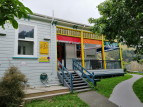The Playcentre House, at 22 Wellington Road, is possibly Paekākāriki’s first private residence. It was built by Emily Susannah Tilley, settler, some time between 1894 and no later than 1899.
As accurately as can be established from government archives, this dwelling, if not Paekākāriki’s very first private home, is certainly amongst the first built and, today, the town’s oldest house.
It was constructed following the draining of Paekākāriki’s lagoon – an area stretching, roughly, from the bowling club to the present site of Playcentre House.
Margaret Shannon, who became the first property owner of the land the house was built on, may well have been related to Mr G. V. Shannon, a leading shareholder in the Wellington-Manawatu Railway Company. The town Shannon was named after him.
Mrs. Shannon granted a seven-year lease of the land to the publican of the Paekākāriki Hotel, Charles Slight. It was later sold to Mr. James Ames in June 1892.
In 1894, Emily Susannah Tilley, settler, bought the property and was most likely to have built the elegant verandah-laced house. Emily was the wife of Paekākāriki hotel keeper, Charles Tilley. She secured a mortgage from the Excelsior Finance Co. of Wellington and it is reasonable to assume that the mortgage was to fund the building this dwelling.
In April 1903, a proclamation took part of Emily Tilley’s section for building a public road, probably Wellington Road, which was built over the Paekākāriki Lagoon reclamation of the same year.
In October 1907, Arthur Thomas Bate bought the house.
In 1909, Robert Charles Brien (a city chemist with a business at 10 Cuba Street, Wellington) became the next owner, holding the title until 1945. (Many old medicine bottles were found during the 1970s restoration process and these would have belonged to Mr. O’Brien.) A Ministry of Works Proclamation in July 1945 saw the Government taking the house to be used as a police station.
In 1962, the Police Department formally declared the house surplus to requirements and handed it over to the Ministry of Works and Development for disposal. Then administered by Lands and Surveys, it was leased to the Civil Amputees’ Society as a holiday home for the disabled, but it was rarely used and fell into disrepair.
In 1954, a playcentre was established by the Plunket Mothers’ Club and operated out of the tennis club rooms – you can still see the remnant of the concrete play-pit in the club’s lawn.
A Government Committee of Inquiry into Preschool Education, in 1971, identified preschool (early childhood) education as a top priority. In response, the government introduced new measures designed to support playcentres.
Paekākāriki Playcentre committee members saw this as an opportunity to make a case for a move from the dingy, and ‘too-small-for-comfort’, tennis clubrooms to a place of their own. Interest was high.
In May 10 1974, the Kāpiti Observer reported that publicity about the need for a new playcentre was attracting a lot of interest from the Paekākāriki community. Notes on the Playcentre and its needs had been sent to all local councillors.
The search widened, and attention soon became focused on the old house, adjacent to the tennis club rooms in Wellington Road. The house was an imposing but ramshackle old building. The fact that the house and section were already government property made it an obvious choice, as it would involve nothing more than a transfer of responsibility from one government department to another.
Playcentre parents spent a lot of time shuffling between government departments in order to save the old house from demolition. Much of this work fell to fathers working in Wellington, who put a huge amount of effort into gaining permission to undertake the conversion of the house. The house’s historical significance gave weight to the playcentre’s contention that the house should be preserved as a community asset.
An application was duly made and, in July 1974, the Department of Education approved the site as suitable for a playcentre. Preliminary plans were drawn by a local architect, Allan Morse. The restoration established the open plan arrangement for the children, with French doors to the outside that opened to a roofed veranda.
The house, with its handsome fretwork detailing, maintains its integrity despite these changes. Mrs Tilley would still recognise her house.
In the playcentre minutes for November 1974, President Barbara Keedwell reported that the initial estimate for improvements to the house was between $10,000 and $12,000. The current building fund, she noted, stood at $1,055. A fund-raising gala day was planned for the following month.
At this time, the playcentre was described in the annual report to the Playcentre Association as being in good heart, with two groups totalling 48 children and 48 families. Two parents were completing their Supervisor’s Certificate.
During the period of restoration, the project became more than just a community effort to provide accommodation for pre-school education. For those involved, their relationship with the old house became something of a love affair.
On Monday 23 May 1977, the playcentre used the new rooms for the first time.
In 2003, floods engulfed parts of Paekākāriki and, consequently, the playcentre outdoor play pit needed rebuilding. The rest of the section survived mostly intact.
Currently, the playcentre remains a well-used and much loved facility in the community.

Playcentre House 1983 – Kāpiti Coast District Council Library Photo (E.D. Long Collection)

2019 View. Paekākāriki Xpressed, 2006, Playcentre History, Caryl Hamer
